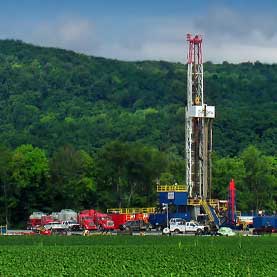 |
U.S. EPA's addition of oil, gas and coal methane emissions to its online greenhouse gas tracking tool revealed an 82.6-million-metric-ton increase in carbon dioxide equivalents over numbers from the previous year, when those figures were not available.
EPA published data yesterday for 2011, adding 12 new sources from the reporting program since last year's 2010 figures. Although carbon dioxide is a much more abundant greenhouse gas than methane, the latter makes a far bigger impact on climate change with more than 20 times the global warming potential of carbon.
Yet carbon emissions from power plants were 4.5 percent lower in 2011 than in 2010, a reduction due in part to the steady switchover of capacity from coal to natural gas, which releases nearly half the carbon of coal per kilowatt-hour. Due to the large impact that power plants have on greenhouse gas emissions, this 4.5 percent drop factored into an overall 3 percent decrease in greenhouse gas emissions between 2010 and 2011.
The comparison over the two years continues to paint a picture of the role natural gas will play in a less carbon-intensive energy system, said Peter Zalzal, a staff attorney in the climate and air division of the Environmental Defense Fund (EDF). While natural gas provides an option to cut carbon emissions from power generation, the leaks and flaring of methane in the production process could undermine the benefits.
"I think the point that we take from here is that we have an opportunity," Zalzal said. "There are very cost-effective solutions to plug leaks throughout the natural gas supply chain."
Despite the significant methane emissions revealed in the oil and gas sector, the American Petroleum Institute (API) promoted natural gas's role in reducing power plant emissions.
"The oil and natural gas industry is leading the way in reducing emissions and is the largest investor in zero- and low-emission technologies," said Carlton Carroll, a spokesman for API. "Today's report confirms that increased use of natural gas for power generation is driving down total U.S. carbon emissions. While we continue to make substantial progress to reduce emissions voluntarily and in compliance with EPA's recent emissions standards, we're also focused on creating jobs and jump-starting our economy."
Coal power still dominates emissions
Last year, EPA completed standards requiring
hydraulically fractured gas wells to use
technology that will cut toxic emissions
and smog-forming pollution by 2015.
As a co-benefit, the upgrades will also reduce methane by up to 1.7 million tons, said EPA. However, environmental groups have said that the methane issue must be addressed separately from other pollutants (ClimateWire, April 19, 2012).
Coal-fired power plants are the largest source of carbon emissions, outpacing the second-largest source -- petroleum and natural gas systems -- by a factor of almost 10-to-1. Power plants accounted for two-thirds of total greenhouse gas emissions.
"It's a vivid demonstration that if you want to take a real bite out of greenhouse gas emissions in the United States, you have to go after power plants. There is no other option for quick and heavy reductions," said Frank O'Donnell, president of Clean Air Watch.
EPA's Facility Level Information on Greenhouse Gases Tool (FLIGHT) allows users to visualize the distribution of major greenhouse gas emitters across the country. The side menu to the tool allows one to search for the heaviest individual emitters in the country. This can help improve the understanding of the sources of climate change on a local level, said EPA at the launch of the website last year (ClimateWire, Jan. 12, 2012).
Coal-fired power to steadily drop over coming
decade
The database tracks greenhouse gas emitters
from sectors releasing more than 25,000 metric
tons of carbon dioxide equivalent per year
in the form of carbon dioxide, methane, nitrous
oxide and other heat-trapping gases. The
2008 Consolidated Appropriations Act requires
that large sources and suppliers of greenhouse
gases report emissions.
Approximately 57 gigawatts of generation -- 16.8 percent of the 339 GW of total coal-fired generation in 2010 -- will be retired between 2010 and 2022, according to the Edison Electric Institute. Reasons for the closures vary from plant age to the lower cost of natural gas, decreased demand, consent degrees, settlements with EPA complaints and the projected costs of future regulatory compliance.
The top emitters have hardly changed from year to year, and seven of 2010's biggest carbon polluters are in the 2011 list. About 1,300 new facilities were required to report for the first time this year.
Last March, EPA proposed the first regulations to control carbon emissions from newly built power plants. The agency is expected to finish that rule this year and propose additional standards for existing power plants.
EPA must also propose a greenhouse gas rule for oil refineries, the third-largest emitters according to the most recent data. While the evidence from new sources is telling, EPA has yet to analyze the data in greater detail.
"It's still too soon to draw broad conclusion about this data," said Sarah Dunham, director of the Office of Atmospheric Programs at EPA.
